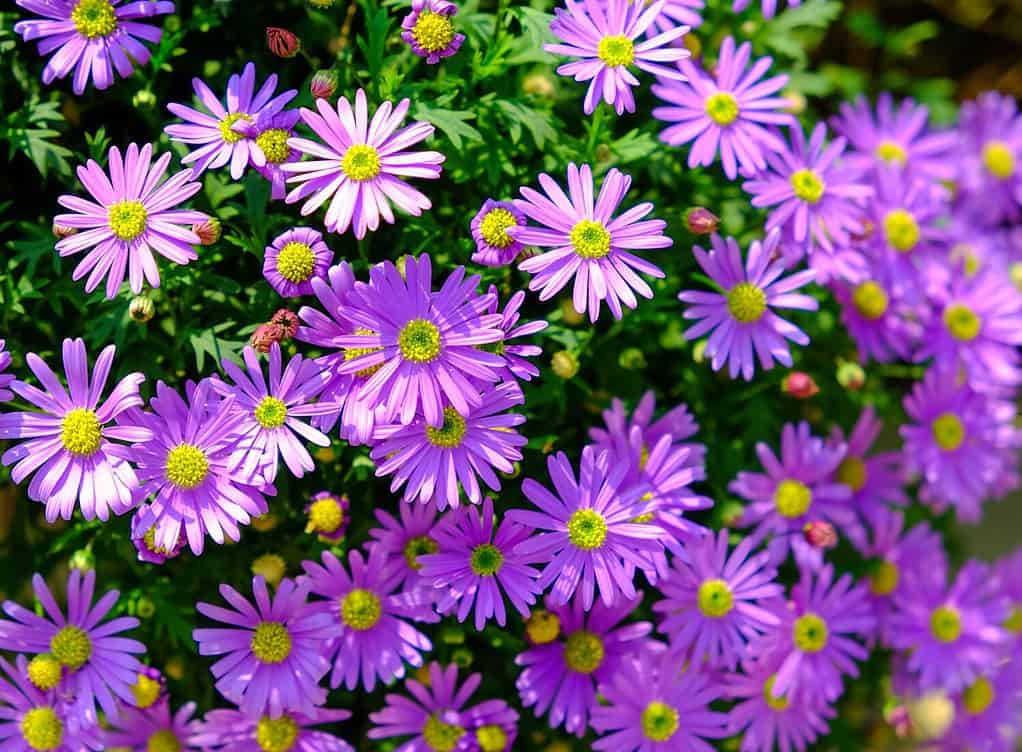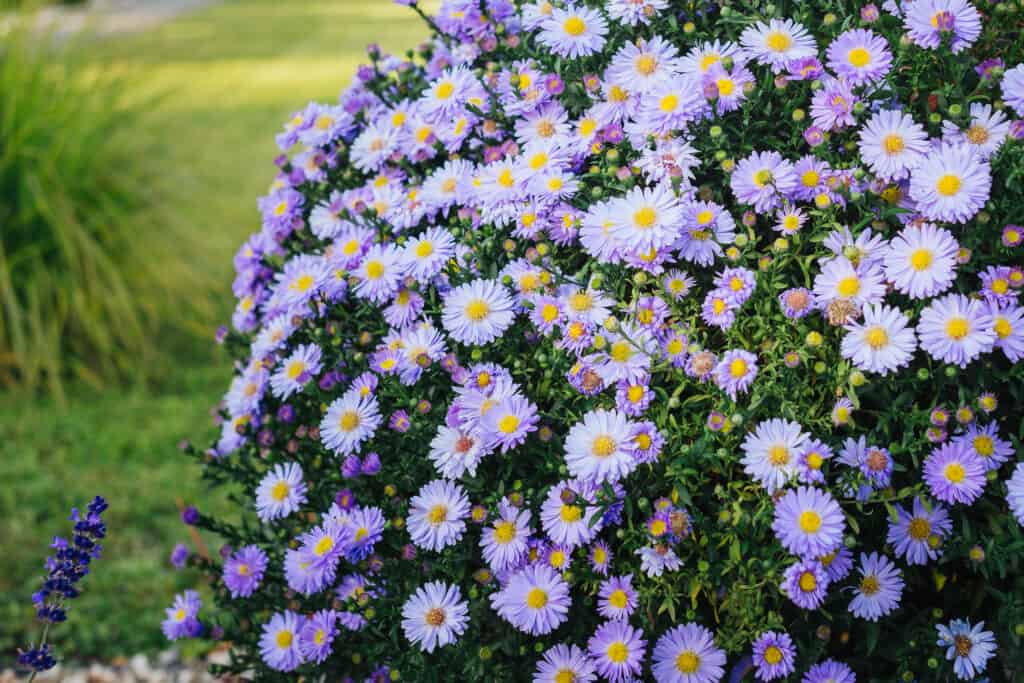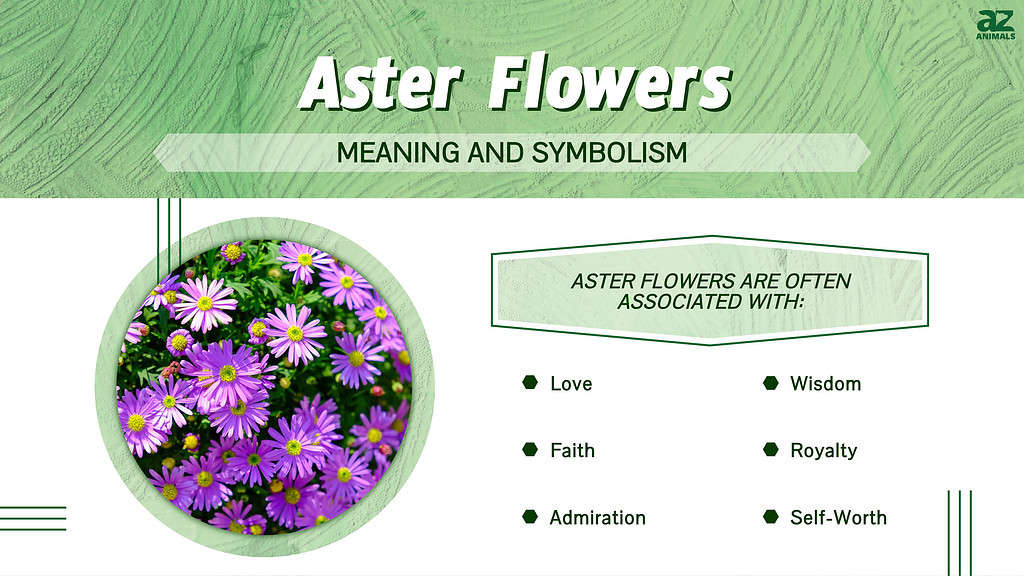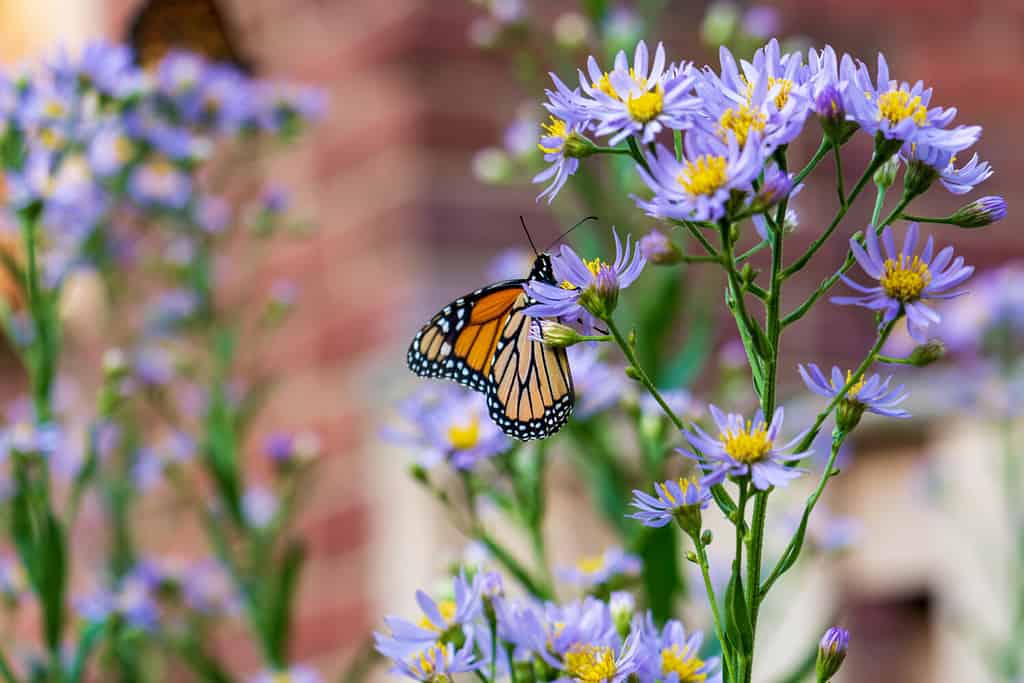Aster flowers are daisy-like flowers that are often lilac-colored with yellow centers. Part of the family Asteraceae, this gorgeous flower has around 170 species. Also known as the Michaelmas daisy, asters can grow around the autumn equinox (during the feast of Saint Michael). The cold-hardy perennial has a rich history and deep symbolism.
Aster flowers are the birth flowers of September. They got their name from the Greek word for “star” since their shape is similar to a star. Keep reading to learn more about what asters symbolize and some special occasions they’re used for.
What is an Aster?
An aster is a flowering plant that looks similar to daisies. Most asters are purple in color, but some are white, blue, or pink. This gorgeous flower is also known to attract the infamous monarch butterfly during its fall migration.

For a brilliant splash of color, consider planting asters in your garden or throughout your yard.
©Linhsiaowei/Shutterstock.com
Appearance
Aster flowers resemble stars. They have round, yellow centers and small clusters of narrow petals surrounding them. The petals are usually purple, white, blue, or pink, giving the flower a pop of bright color. In terms of size, the delicate plant usually grows between 1 to 6 feet tall.
Native Habitat
Originally, aster flowers originated in Europe and Asia. However, they now grow all over the world today. As cold-hardy perennials, asters thrive in various climates. They’re also native to rocky parts of the eastern United States.
Growing Tips
Asters prefer cool climates with full sun, as this will help them flower. They also flourish during moist summers but don’t do as well in the heat. Generally, they thrive in USDA Hardiness Zones 3 to 8, but they can survive in some higher zones.
Asters prefer well-drained, loamy soil. You can plant them during any season, but if you’re in colder climates up north, plant them any time before autumn so they have a chance to develop a root system before the cold months. Once established, these plants can survive near-freezing temperatures, so little winter care is required.
Asters can even thrive in rocky gardens or wildflower gardens. They’re most popular during the transition between summer and autumn, which is when you’ll notice their beautiful blossoms. Just be sure to keep the soil moist (but not overly watered, as this will cause root rot).
Can Asters Be Grown Outside?
Yes, asters can — and should — be grown outside if you live in zones 3 to 8. Some aster species can do well in higher zones/hotter climates, and they are frost-hardy.
Asters don’t typically do as well indoors, but they can survive as a potted plant with the proper care. Inside, they must be kept in a cool yet not freezing location.
Aster Flower Meaning and Symbolism
The aster flower carries deep symbolism and spiritual significance. Here are the specific meanings of aster flowers and their associated themes.

The fall aster plant is native to rocky soils in the eastern United States.
©Open_Eye_Studio/Shutterstock.com
Love
Asters are known as a symbol of love for someone or something. In fact, in Greek mythology, the aster was the herb of Venus, the goddess of love. Additionally, many used aster flowers to decorate the altars of the gods.
Another Greek legend refers to Astraea, a “Starry Maid” who cried because there were no stars on the Earth. As a result, aster flowers grew from her tears and painted the Earth with star-like emblems, representing love.
Wisdom
The aster flower is also a symbol of wisdom. Many of us “look to the stars,” so to speak, for guidance and insight. Aster flowers are like the stars of the Earth (rather than the sky) and signify deep spiritual wisdom.
Faith
Many people view asters as symbols of faith. Even when everything feels dark to us, there is always a light at the end of the tunnel. Think about the night sky — though it’s dark, we know it’s filled with bright stars. With asters representing stars, we can view them as signs of hope and faith in better days.
Royalty
The most common color of aster flowers is purple, which is closely tied to the idea of royalty and valor. In fact, members of European civilizations often wore purple to demonstrate their stateliness. When seeing the purple aster, you can take it as a sign of your own personal power, boldness, and majesty.
Admiration
As mentioned earlier, in ancient Greece, many individuals used aster flowers to adorn the altars of various gods as a token of their admiration. The flower is still an emblem of affection today. For instance, sending someone a bouquet of aster flowers can serve as a reminder that you’re grateful for them and admire who they are.
Self-Worth
While we usually think of others as the recipients of our admiration, we deserve to admire ourselves just the same. The aster flower can act as a symbol of our self-worth, reminding us not to take our own strength, wisdom, and uniqueness for granted.
Purity
Astraea, as mentioned above, was closely tied to the aster flowers. She was also the virgin goddess of innocence and purity. As a result, many view the aster flowers as a symbol of purity and virtue.
Patience
Often touted as physical manifestations of stars, asters symbolize our deep wishes. When you wish upon a star, you’re told to have patience for it to come true. That’s why this flower is often associated with the virtue of patience. Have faith that your dreams will manifest into your reality if you are willing to sit back and have faith while waiting.
Spiritual Significance
Spiritually, aster flowers remind us of the convergence of love, wisdom, and faith. Each of these virtues helps us hold close to what’s most important to us.

Aster Flower Proper Occasions
The aster flower makes the perfect bouquet, decoration, or gift for the following special occasions.

Monarch butterflies love asters, and having this flower in your garden can attract this beautiful creature.
©Liz Albro Photography/Shutterstock.com
September Birthday
As the birth flower of September, asters make the perfect gift for your Virgo or Libra pals. If your loved one was born in the month of September, send them a bouquet of asters to remind them of your love for and admiration of them.
20th Wedding Anniversary
With its symbolism of love and wisdom, the aster is the flower of the 20th wedding anniversary. After two decades of marriage, you’ve likely gained a ton of wisdom about you and your partner’s love as well as admiration for them. Gifting them a bouquet with asters will express your gratitude for them and their commitment to your marriage.
Appreciation Gift to Yourself
A great symbol and reminder of self-worth, asters can also serve as a token of self-care. Whether you’re having a bad day and need a pick-me-up or are simply looking to celebrate yourself for all that you are, purchasing a bouquet of asters will surely brighten your day.
Baby Shower or New Mother
Because they symbolize innocence and purity, aster flowers are perfect for baby showers or for new mothers. If someone you love recently announced their pregnancy or gave birth, buy them a bouquet of asters to commemorate their beautiful new life.
Aster Flowers: Bottom Line
Not only are aster flowers gorgeous and hardy plants, but they also carry deep spiritual symbolism that only adds to their essence. Whether you’re looking for the perfect garden flower or want to celebrate a special occasion with a bouquet, asters make the perfect addition to any space.
The photo featured at the top of this post is © iStock.com/Inna Giliarova
Thank you for reading! Have some feedback for us? Contact the AZ Animals editorial team.







